Scottish technology ecosystem: review
Review of the Scottish tech ecosystem by Mark Logan, commissioned by the Scottish Government, with recommendations on how to develop a world-class tech sector.
Chapter 3 – Ecosystem Supporting Categories – Infrastructure
The technology ecosystem’s second dependency is on Ecosystem Infrastructure. In this section, we’ll first define what we mean by the term Ecosystem Infrastructure. We’ll then examine each of the funnel stages and identify areas for improvement in this category. Finally, we’ll outline an overall strategic approach for how our ecosystem infrastructure could be systematically improved in support of our ecosystem. In the final section of this document, we’ll present consolidated recommendations resulting from this strategy, alongside those in the other supporting categories of the ecosystem (Education and Funding).
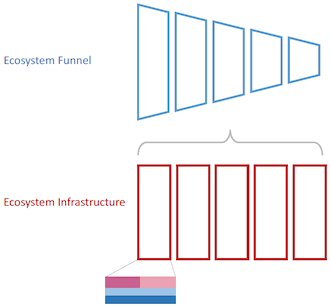
Definition of Ecosystem Infrastructure
Expanding the lower-left part of the above diagram, the ecosystem funnel depends on the following infrastructure being sufficiently available at each stage of the funnel:
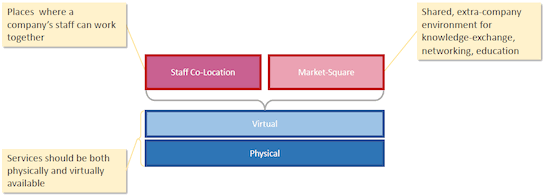
Infrastructure, in the ecosystem context, is often mistakenly thought of as only relating to Co-location; i.e. the (usually) physical offices and associated resources out of which start-ups can work. This is certainly an important component of the category. But the Market square category is equally important.
To define and to illustrate the importance of the latter category, consider this example: the Edinburgh tech start-up scene today exhibits the following desirable attributes to a reasonably evolved extent while the Glasgow start-up scene largely does not:
- A strong sense of identity and confidence. Start-ups believe that they can be successful in their chosen location and that there’s a peer-support network around them.
- A well-known place where ecosystem participants can meet, attend talks, share ideas, be efficiently introduced to prospective companies and future employees and feel part of a thriving community.
- A place where investors can access multiple businesses easily. As we’ll discuss further later, this is particularly important for venture firms outside Scotland. Relative to working with companies in London, where each prospective portfolio start-up is a short tube-ride away, there’s considerable time involved for a VC in visiting Scottish start-ups. Having a single meeting point where investors can assess several interesting candidates in one visit is helpful.
What accounts for the difference between the cities? In the large part, organisations such as Codebase, Turing Fest and EIE/Informatics Ventures, all based in Edinburgh and which, along with several others, instantiate the above environment there to a much greater extent than
is to be found in Glasgow.
It’s germane here to note that an important component of the world’s great renaissance cities in history was the market square where people with differing skills and experience could intermingle and share ideas. Large tech businesses understand this and create market squares within their own worksites towards the same end. They have the resources to extend those market squares outside of their companies (for example to connect with peers in the Silicon Valley). Earlier-stage businesses rely on others to provide them, for example, within incubators, at meet-ups, founder dinners and in conferences. A key ingredient in the success of the tech ecosystems in Finland and Israel is the degree of “connectedness” between their respective participants, promoted through a high level of networking mechanisms.
Each of these categories – co-location and market square – needs to exist in both physical and virtual forms. Even without the additional requirements placed on working arrangements brought about by COVID-19, being able to participate in both co-location and market square categories remotely from physical centres is important, for several reasons:
- Enabling businesses to hire from a larger talent pool.
- Balancing work and life more easily, which has the effect of bringing more skilled people into employment and retaining more of them. It is also likely to improve gender balance and diversity profiles within our start-ups.
- Opening access to expertise, education and community identity throughout all of the regions of Scotland. This is an essential component of making our ecosystem operate effectively in a COVID-19 world.
Physical interaction will continue to be important too. COVID-19’s aftermath (whenever the day might arrive when we can safely talk about an aftermath) won’t completely, or even largely, remove the requirement for some level of physical co-location. Therefore, affordable, low-friction access to these physical facilities will also continue to be essential.
Summarising the above, we can expand the core-services that need to be provided by the ecosystem infrastructure at each stage of the ecosystem funnel as follows:
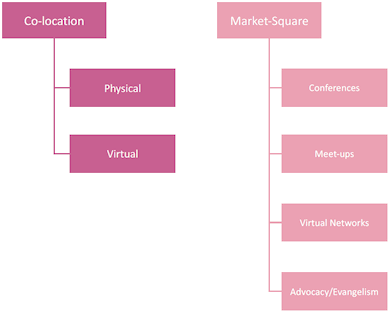
In our earlier analysis of the Education ecosystem-supporting category, we discussed how the third stage in the Education Funnel (educating our start-up leaders, etc.) is critically important and that Ecosystem Infrastructure is one of the platforms from which much of this education can be delivered, in both the formal sense and through more indirect, market square activities.
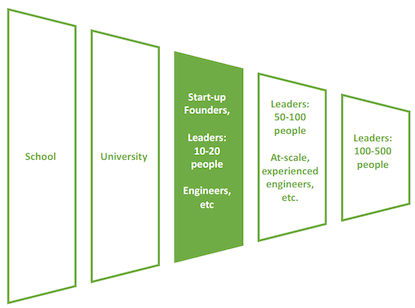
Therefore, it is a more complete depiction of our Ecosystem Infrastructure requirements to include reference to this element, for the purposes of our analysis that follows:
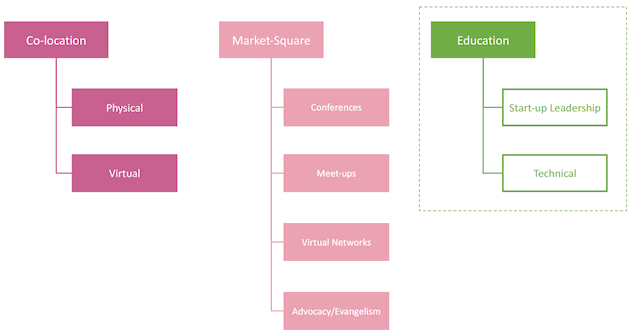
Analysis – Provision of Co-Location and Market square Infrastructure
The adequacy of provision of the Co-Location and Market square infrastructure components varies by funnel stage:
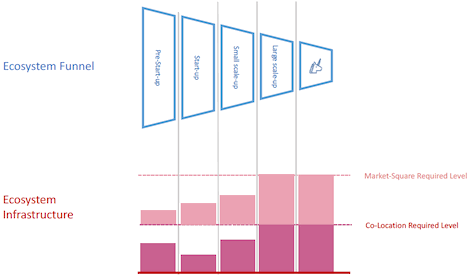
Later funnel stages (large-scale up and beyond) are increasingly capable of meeting their own needs from their own resources as we move from left to right through the funnel. Co-location and access to the market square become easier as a company scales – it has more resources, including financial, to secure that access.
The exception to these general trends is co-location at the pre start-up stage – it’s easier for a two-person business to find shareable working spaces – a spare room in a house will do (though this is not ideal, of course, and does not grant access to a market square). The task then immediately gets more difficult as the start-up progresses beyond this minimal scale, before aligning to the general trend described above.
In view of the above trends, our analysis will focus on addressing the general infrastructure shortfall in the earlier funnel stages. To perform that analysis, let’s first map out the ecosystem participant types that fulfil these infrastructure services in Scotland today. There is often confusion as to the differences between participant types in the Ecosystem Infrastructure. For example, the terms incubator and accelerator are often conflated.
In our analysis of our provision of Ecosystem Infrastructure that follows, we’ll use the following model, for clarity. As we will see, these definitions are helpful in identifying areas of under-provision.
| Participant Type | Co-location | Typical Size | Market square Activities | Education |
|---|---|---|---|---|
| Incubator | Long-term | Medium to Large | Yes, medium to large | No |
| Accelerator | Short-term | Small | Yes, small | Yes |
| Temporary Market squares (Meet-ups, Conferences) |
No | Small to Large | Temporary, Regular | Yes |
We now explore existing issues and areas for improvement in our Ecosystem Infrastructure, using the above table of participant types as well as other considerations for context.
Insufficient Incubation Capacity
At first glance, it appears that Scotland is well served by infrastructure participants. Across Scotland, a simple search will return over 50 accelerators, incubators and innovation centres providing a mix of co-location, market square and education services. But, when we apply the above definitions, we find that important areas of under-provision emerge. Our analysis finds that, supporting the tech ecosystem in Scotland, there are:
- 13 Accelerators,
- 8 University Incubators, and
- 3 Non-University Technology Incubators.
Accelerators are very valuable to the ecosystem because of the concentrated founder education that they provide. But tenure for start-ups admitted to accelerators is relatively short, ranging from a few weeks to a few months. At the end of an accelerator programme, the start-up loses both its co-location and its market square. The number of simultaneous businesses resident within accelerators is typically small, which means that the market square within them is small too, and somewhat homogenous (the start-ups are the same size, with consequently limited scope for cross-learning). This is why genuine incubators are very important to the ecosystem – start-ups need a semi-permanent place to locate, until increased scale eventually takes them to their own premises. And they benefit from a larger, heterogeneous market square, which a scaled incubator can provide.
University incubators are generally very small and restricted to current or recent students, and staff. Though undoubtedly valuable in the context of their specific remit, they can’t be considered as a general solution to incubation.
Of the three general tech incubators, only Codebase in Edinburgh has achieved relative scale and relative success (it also has a growing presence in Aberdeen and Stirling, none in Glasgow or elsewhere). However, prior to COVID-19, the incubator was essentially full, and turning away viable start-ups that would otherwise have passed its curation assessment process.
This general lack of semi-permanent incubation infrastructure must be addressed by our ecosystem strategy. Later in this section, we’ll examine some of the reasons for the lack of incubation space in the ecosystem. But first, let’s examine the other important dimension as regards incubation, namely alignment of our existing incubation services to what’s required in the ecosystem if it is to perform better.
Provision of Incubation Services
The second dimension to incubation is the breadth and quality of the provision of required services that incubators provide. With the emphasis placed on founder education in this review, we believe that the ideal incubator model would be one in which incubators provide long-term co-location and market square services, including virtual access, and provide a platform for on-going formal start-up education, or low-cost access to it. How do our current incubators compare to this standard?
As the most evolved example, we’ll use Codebase Edinburgh as the basis of this comparison.
Co-location
Very Good. A wide range of low-cost accommodation sizes and associated meeting space, with flexible leasing. On-going tenancy is subject to two criteria:
- On-going curation – i.e. does the start-up still meet or exceed the original selection criteria. This ensures that the available space is directed to the most promising businesses and also ensures that the market square aspects of the incubator maintain a relatively high quality.
- Size – eventually scaling businesses must relocate, to make way for new start-ups. Otherwise, subject to the point above, they have indefinite tenure.
Traditional property models are not well suited to start-ups, with high costs due to start-ups’ lack of covenant strength and long lease terms. Larger incubators like Codebase provide a bridge for start-ups due to their own scale, where costs can be reduced by leveraging stronger covenants (especially when partly state-funded). Incubators also significantly benefit start-ups in accessing affordable, high-speed internet connections, where economies of scale again come into play.
Codebase hosts businesses of varying sizes, from 1-2 person start-ups to those with up to 80 employees. This has the considerable advantage that earlier-stage businesses can learn from later-stage businesses. In other words, the market square is much enriched by this mix. Contrast this situation with the more prevalent approach in many incubators and accelerators, where all of the tenants are at exactly the same stage, and where the market square’s value is correspondingly reduced.
The physical building in which Codebase is housed is, however, tired and not well laid-out for incubation. In a more adapted building, Codebase would score more highly in this category.
Scale (within Edinburgh)
Very Good, but full. Prior to COVID-19, the incubator was full and having to turn away clients that would otherwise have passed the entrance criteria. At that point, Codebase housed over 80 start-ups of sizes ranging from two to 80 staff. Although COVID-19 will cause several start-ups to leave Codebase, we should assess this point on a longer timeframe – i.e. it is likely that Codebase will become full again quite quickly.
Scale (Scotland-wide)
Good but could be improved. For example, Codebase has no presence in Scotland’s largest city.
On a separate point in this category, the organisation, which itself is a start-up, also needs to continue to evolve its corporate governance and leadership model, in order to support further scaling, as with any other start-up moving through levels of scale.
Market square activities
Very Good. Codebase has become regarded by the tech community as the heart of Edinburgh’s tech scene. There are regular meet-ups, presentations and networking events held there. Many of Edinburgh’s meet-ups have gravitated towards the location. Codebase has created an atmosphere and “vibe” where start-ups want to be. This is important – if the start-up community embraces a location’s style and atmosphere, it is far more likely to attract the most promising start-ups. Credit should be given to the Codebase team for achieving this status, even within a non-ideal physical space – the Codebase building isn’t physically well-suited to collaboration and accidental conversations between start-ups. Although earlier in their lifespans, ONE Codebase in Aberdeen (a partnership between the excellent ONE programme and Codebase) and Codebase Stirling are also rapidly moving towards this status locally, albeit at a smaller scale, currently.
Education
Lacking. Although Codebase provides founder education services, most of these are not directed towards tenants. The reason for this is that the organisation has been forced to earn money through the provision of corporate education outside of Scotland in order to mitigate the low rents it charges (and needs to charge) to tenants.
Virtual/Remote-Access
Lacking. Codebase is configured towards in-person attendance. Meeting spaces tend to be poorly equipped for remote participation relative to best practice while, events, meet-ups, etc. tend not to be live-streamed or virtually accessible/and or recording equipment is relatively poor.
So, in summary of the above, two points emerge: firstly, the success rate of start-ups such as those in the Codebase incubator could be improved through access to best practice education services and more suitable facilities, were the money and will available to provide them. Secondly, Scotland’s general tech incubator provision is small and inconsistently available across our major population centres.
This raises the question: is the size of the ecosystem (in terms of participants) restraining the scale of the infrastructure, or is the scale of the infrastructure restraining the size of the ecosystem? Given that Codebase regularly must turn away credible start-ups and has no presence in Glasgow, Scotland’s largest city, we argue that the latter is the case. If this is indeed the case, then what is the constraint on increasing the size of this vital component of ecosystem infrastructure? We’ll explore this point in detail next.
Barriers to Scaling Ecosystem Infrastructure – Pre-Tipping point state of Ecosystem
A general barrier to scaling Scotland’s incubator infrastructure is the pre-tipping point state of the ecosystem. To be clear, this barrier can be surmounted. But to do so, we must understand its nature and adjust our interventions accordingly.
To illustrate the significance of this pre-tipping point state to the funding of our incubators and accelerators, let’s compare Codebase, Scotland’s most successful incubator with Silicon Valley’s famous Y-Combinator accelerator. Y-Combinator funds itself by taking a large (7%) stake in every tenant start-up in return for its services and $150k in funding. Why can’t Codebase and others in Scotland do the same?
Y-Combinator was started in 2005, born into an already very mature ecosystem. The ratios of companies growing to scale versus those that don’t is far more favourable than in Scotland, a pre-tipping point ecosystem. Its curation process yields a set of businesses with a relatively high likelihood of success, and much higher than in Scotland. Therefore, Y-Combinator can rely on a relatively predictable revenue stream.
In Scotland’s pre-tipping point ecosystem, on the other hand, there is a much longer and far more uncertain period between an equity stake being placed and a return being generated, and the returns are fewer in number. And because Codebase doesn’t manage a fund, the equity stake taken in its tenant start-ups must be correspondingly smaller. Provided Codebase is extremely careful in how it manages its costs, this could work. But it certainly isn’t a recipe for scaling incubation space to meet demand, in the pre-tipping point state.
Therefore, Codebase relies on two main funding sources outside of grant support. The first is rent from tenant start-ups. In return for a necessarily relatively low rent (the tenant start-ups have little money, remember), Codebase returns physical co-location and various market square benefits. If the start-up becomes successful, the early value contributed by Codebase is accounted for outside of Codebase, and none of that value is returned to Codebase. During the journey to scale, the start-up will leave Codebase to seek larger, more permanent business premises. Therefore, Codebase only ever receives revenue from early stage companies that can’t afford to pay much towards their rent. This places a considerable limit on its scale, which is exacerbated by the high-failure rate that start-ups inevitably experience.
Therefore, it is difficult for Codebase to invest in expansion beyond that supportable by those tenant rents. The organisation barely breaks even (and the COVID-19 situation has made even this modest goal very challenging).
This reality has caused Codebase to put a considerable amount of its time and energy into paid training activities in London and elsewhere, which bring little benefit to its Edinburgh, Aberdeen or Stirling-based tenants. In a system with better overall alignment to ecosystem goals, Codebase could focus that energy on its Scottish start-up tenants, which is very much in the spirit of this review.
Only where Codebase has been partly supported by public or private (in the case of ONE) funding has it been able to provide services to cities in our pre-tipping point ecosystem. But overall, provision of this kind of funding is ad-hoc, sporadic and does not currently follow a country-based strategy. This brings us to our second barrier to scaling incubation space…
Barriers to Scaling Ecosystem Infrastructure – Funding misalignment to Ecosystem goals
The primary purpose of Ecosystem Infrastructure is to create value for start-ups within the Ecosystem. This value manifests months or years after the initial investment in the ecosystem is made, and manifests within the companies supported by the infrastructure rather than in the infrastructure itself.
This presents difficulties for public funding bodies seeking to justify support for infrastructure ecosystem partners. For example, it is certainly convenient for a funding organisation to assess an incubator like Codebase on direct P&L terms (the inner circle below) rather than on the value delivered to the ecosystem) outer circle. But to do so is to entirely disregard the value created by the incubator.
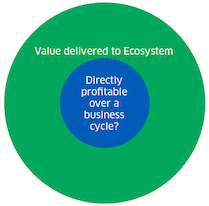
Another approach is to assess the incubator on the basis of deal-flow. Here the argument is that the incubator should be funded according to the general rate of investible start-ups that it produces – i.e. success funding further success. But, as we have discussed above, in a pre-tipping point ecosystem, this deal-flow is somewhat sparse. It will strengthen as the ecosystem approaches its tipping point but, in the meantime, deal-flow is a problematic way of assessing funding support (by contrast, on the other side of the tipping point, public funding support for incubators could be reduced or even withdrawn over time as deal-flow becomes sufficient to sustain the incubator).
Such is the infliction of an incubator in a pre-tipping point ecosystem. It can’t fund its own way to scale through rent and it struggles to receive grant funding because the funding process doesn’t easily recognise the value created by Codebase within the ecosystem at large. It is, perhaps, the archetypal example of the essential need to embrace the differences between local and global optimisation of the ecosystem, if we are to make progress.
Barriers to Scaling Ecosystem Infrastructure – Analogous Issues for Conferences, Meet-ups
Recalling our identification of ecosystem infrastructure participants from above, we identified a third category, after Incubators and Accelerators, which we have named Temporary Market squares, for the purpose of this analysis. These are organisations which provide temporary market square services at a given frequency rather than operating a physical market square. Larger examples in Scotland include Turing Fest’s conferences and founder-dinners, DataLab’s[24] DataFest, ScotlandIS’ Scotsoft[25] and FutureX’s Start-up Summit[26]. Smaller examples are the more than 200 regular meet-ups that take place in Scotland.
| Participant Type | Co-location | Typical Size | Market square Activities | Education |
|---|---|---|---|---|
| Incubator | Long-term | Medium to Large | Yes, medium to large | No |
| Accelerator | Short-term | Small | Yes, small | Yes |
| Temporary Market squares (Meet-ups, Conferences) |
No | Small to Large | Temporary, Regular | Yes |
We can generalise the funding misalignment issues discussed earlier across to the market square actors in our ecosystem. Let’s take the example of Turing Fest which is arguably our most successful international start-up/technology conference, and the only one focussed purely on technology start-ups. Turing Fest also runs an investment conference and regular founder education sessions. The organisation has considerable ambition to develop Scotland as an international market square along the lines of Finland’s model, to which talent and teaching expertise is attracted. If we were to consider the simple P/L statement of the organisation, we’d see that it essentially just about breaks-even. We’d perhaps question whether any investment in the organisation is wise.
But if we give proper consideration to its external, market square value creation, the situation would look different. For example, at the Turing Fest conference, 800 attendees interact with each other and are both peer-educated and expert-educated. Networks are formed which provide on-going learning and shared experience. Start-ups find employees, and people find jobs. Overall, considerable value is returned to the wider ecosystem. As a reference point here, one of the key focal areas of Finland’s approach has been to use similar mechanisms for both stimulation of peer-networks within the tech community and to present Finland as a credible global destination for technology and start-ups.
Assessing our “temporary market square providers” through a P/L lens rather than with respect to value returned to the overall ecosystem has a number of consequences for organisations such as Turing Fest. The first is that conference ticket prices tend to be beyond the reach of many start-ups. The second is that it is difficult to attract enough of the best international educators to our conferences. Such speakers usually expect to be compensated. Therefore, too high a proportion of the educators are inexperienced, local start-up founders and executives. In effect, the blind are leading the blind.
At the other end of the scale from Codebase and Turing Fest are the dozens of tech meet-ups that regularly take place throughout Scotland, organised by volunteers and paid for by those same volunteers, or through occasional sponsorship. There are over 200 meet-ups of which we are aware. Their frequency and volume of attendance is limited by their ability to find and pay for premises in which to hold those meet-ups. But their educational value, in aggregate, is immense. They don’t suffer the same risk of parochialism that leadership-oriented conferences do because they are more technical in nature, and those skills are far more available in Scotland than start-up leadership skills.
A greater provision of physical market squares for our meet-ups (through an expanded incubation capacity), complemented by excellent remote-access facilities, would significantly increase the reach and participation in these events.
The preceding discussion asserts that traditional funding assessment mechanisms are not well-suited to measuring the value that ecosystem infrastructure provides and that this mismatch risks strangling our ecosystem through inadequate support for pre-tipping point ecosystem infrastructure. We also discussed that the reason for this mismatch is that the value generated by ecosystem infrastructure is always manifested outside of this infrastructure and months, or even years, later.
This, of course, raises the question as to how a more appropriate assessment mechanism should work, and which organisations would be within its scope? There are various ways in which this question could be answered. In the recommendations section of this document we will propose one such approach. But we recognise that other good options also exist.
We now examine further areas in our provision of ecosystem infrastructure that should be improved.
Market square and Education focus is generally too parochial
As we touched-upon above, and in our analysis of Education provision, it is extremely important that a pre-tipping point ecosystem educates itself from sources that include those outside the ecosystem. This is because the ecosystem participants, prior to the ecosystem’s tipping-point being reached, do not possess enough exposure in sufficient volume to world-class, best practice start-up methodologies at the various levels of scale that growth brings. When participants in an ecosystem only learn from each other, a relatively low ceiling is placed on expertise within that ecosystem. Scotland needs to regularly escape these “local-optima” if it is to bring its tech companies consistently to global best practice.
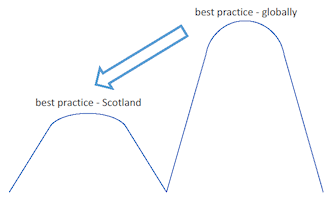
This consideration extends also to market square provision. A permanent, physical market square – such as is to be found in an incubator like Codebase – tends towards peer-to-peer education because of the interaction between start-up tenants. This still has significant value, of course, but it must be complemented by a healthy dose of external participation and input. Conferences (our temporary market squares) such as Turing Fest, Start-up Summit, Scotsoft and DataFest are also particularly well-placed to act as a platform for external participation.
Overall, today in Scotland’s ecosystem, there is too little external participation in our market squares. The ability of our conferences to attract external speakers is financially limited and, compared to, for example Ireland, we make limited use of our international diaspora, nor do we have a clear country-level strategy to develop it.
We note, in this regard, Turing Fest’s ambition to take its brand and formula world-wide in order to create a network of international conferences, configured in such a way as to place Scotland at the centre of that network. This is modelled on the successful Slush model in Finland, which brings expertise and talent (both on a temporary and permanent basis) to the country. It would seem that, as part of our consideration of this category, we should reconsider funding such an initiative on an exploratory basis. We’ll return to this topic in our recommendations section.
Size of Scotland’s start-up-savvy population, and relationship to infrastructure
Scotland’s start-up-savvy population size is small and this acts to constrain start-ups as they attempt to scale. This state of affairs is not directly brought about by ecosystem infrastructure issues, of course. But, as we will shortly examine, our ecosystem infrastructure strategy has a significant impact on the effective size of this population in practice.
Our ecosystem infrastructure strategy should act to maximise the size of the indigenous tech start-up-savvy population available to our businesses whilst other initiatives act to encourage talent to come to Scotland. In this regard, and additional to questions of education covered elsewhere in this document, there are a number of current barriers to maximising this population size that we should address. These are covered in the next three points below.
Population Constraints – Lack of virtual/remote participation in market squares
We have touched upon this point earlier, but it is such an important area that it merits its own category. Today most of Scotland’s conferences are not live-streamed and our meet-ups, founder-dinners and similar events require in-person attendance. Our incubators are designed for in-person participation only. This limits the participation of regional start-up founders and caps the number of attendees generally. COVID-19 is forcing us to reconsider prior norms in this area. We believe that there is a significant opportunity to capitalise on our cultural re-baselining in this area.
For example, if our physical market squares were enabled with frictionless, high-quality virtual/remote-attendance facilities, and if our meet-ups took place within them, we could dramatically increase their reach and conference attendance figures. Conferences worldwide that have been virtualised during the COVID-19 crisis have found that attendances of up to ten times the normal rate are possible.
Population Constraints – One-city versus multi-city strategy
In the past, policymakers have debated whether to concentrate Scotland’s high-tech start-up sector – along with any support provided – in one city (Edinburgh) or whether instead to take a more country-wide approach. The former approach has tended to hold sway over time.
There are many considerations in respect of this point, but our summary view is that concentrating efforts on one city only is detrimental to the performance of the overall ecosystem, including to the city in which efforts are to be concentrated.
As stated above, Scotland’s start-up-savvy population size is small and this acts to constrain start-ups as they attempt to scale. This effect is accelerated when more businesses start to become successful, in line with improvements to the ecosystem. In effect, they will fight over the same employees within a limited hiring radius. In a post-Brexit UK, where the availability of European talent will be much reduced, the problem is already set to worsen. In this context, the larger the general start-up-savvy population across the country is, the better. Therefore, our strategy should be to be region-wide to the greatest extent possible.
Population Constraints – Cost of travel in Scotland severely constrains hiring radius for start-ups
A distinct but related further consideration is the ability to easily and/or affordably travel between city locations. For example, the cost of rail travel between Edinburgh and Glasgow – our two most populated cities – is among the most expensive rail journeys per mile in Europe, with the cheapest fare option costing approximately £4200 per annum, at the time of writing. This effectively disqualifies many people living in one of our two largest cities from working in businesses located in the other. Or it requires start-ups to open offices in both cities if they wish to hire across the central belt, which in itself is prohibitively expensive.
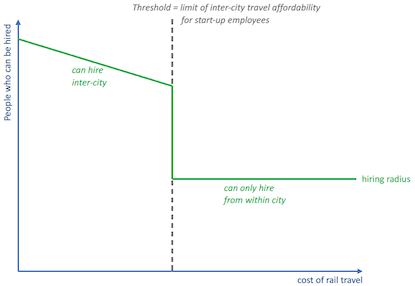
The effect of the cost of travel, once it rises above a certain threshold, is to constrain start-ups’ ability to hire to a relatively small radius around their home city (the relationship between travel-cost and hiring radius is not linear because the population is not evenly distributed across the country). Below that travel cost threshold, the hiring radius is much larger because the start-up can attract people living in other cities.
In a small country like ours, with a relatively small population, it is highly desirable to understand where that cost threshold asserts itself, and to intervene on inter-city travel costs accordingly. This is another example of an intervention that might be difficult to achieve when considered in isolation but that will have significant positive effects on the overall output of the tech ecosystem (and, indeed, other business ecosystems).
Lack of direct US flights constrains participation of US venture capital firms, expert speakers
Venture capital (VC) firms operate on high-ratios – for every investment made, a VC will consider literally hundreds of potential candidates. For this to work, the minimisation of friction from this sifting process is extremely important. Where greater friction exists, VCs will avoid working in those areas. In the case of attracting investors from the US and, in particular, Silicon Valley, there are virtually no direct-flight options to Scotland. The same applies to attracting, for example, expert Silicon Valley speakers. We shouldn’t under-estimate the impact this has on our ability to attract Silicon Valley investor interest and Silicon Valley-based speakers and educators, where a very high value is placed on time, in each case. In so saying, we do recognise that assessing this particular point in the context of the global climate crisis and in the age of COVID-19 is not straightforward.
Infrastructure – Strategic Framework for Improvement
From a review of the above issues, we can determine elements that an ecosystem infrastructure strategy must possess. In the Recommendations section of this report, we’ll convert these elements into a set of specific recommendations, alongside those suggested by our analysis of the Education and Funding category analyses.
We consider the elements of that strategy to be as follows:
- There is a gap between the services provided by our incubators and accelerators today and the required level of service provision if the ecosystem is to thrive, for example with regard to start-up team education services (both market square based and formal), remote participation and presence in major cities. Our strategy should address closing this gap.
- Our ecosystem would benefit greatly from the creation of a new type of entity, which we’ll term here a “Tech-Scaler”. This is based on the core capabilities of incubators but extends these to include the education services provided by accelerators and then extends them further to include intensive formal education in Internet Economy skillsets. Access to all services, including all education and market square activities, is seamlessly provided in virtual as well as physical formats.
- We should act to increase Tech-Scaler capacity. Coverage should include more of our major cities. The provision of any public funding in support of this imperative should take into account two points. The first is the pre-tipping point nature of the ecosystem, the second is that most of the value provided by existing incubators to start-ups is eventually realised outside of the incubator and outside of typically applied assessment timeframes. A new treatment is required that ensures responsible investment in this national resource whilst taking account of these points.
- Provision of education services delivered using Tech-Scalers as a platform should not be parochial but should instead be based on the best available international training resources, to ensure that global best practice is inculcated into our start-ups.
- Similarly, the strategy should recognise the considerable value provided to the ecosystem by other market square providers, both large and small. Again, a gap exists between current and required levels of service provision, in the case of the top-tier providers. The strategy should operate to incentivise and support increasing the quality, level of internationalism and the affordability of the market square services that they provide. And, in regard to the internationalisation of our approach, a specific strategy should also be developed on the exploitation of Scotland’s diaspora.
- The strategy should work to maximise the start-up-savvy talent pool available to Scottish start-ups. For example, it should not concentrate on one city and should also endeavour to make travel between our cities as affordable as possible. And it should attempt to attract international talent to Scotland to the maximum extent possible within policy constraints.
Contact
Email: loganreview@gov.scot
There is a problem
Thanks for your feedback